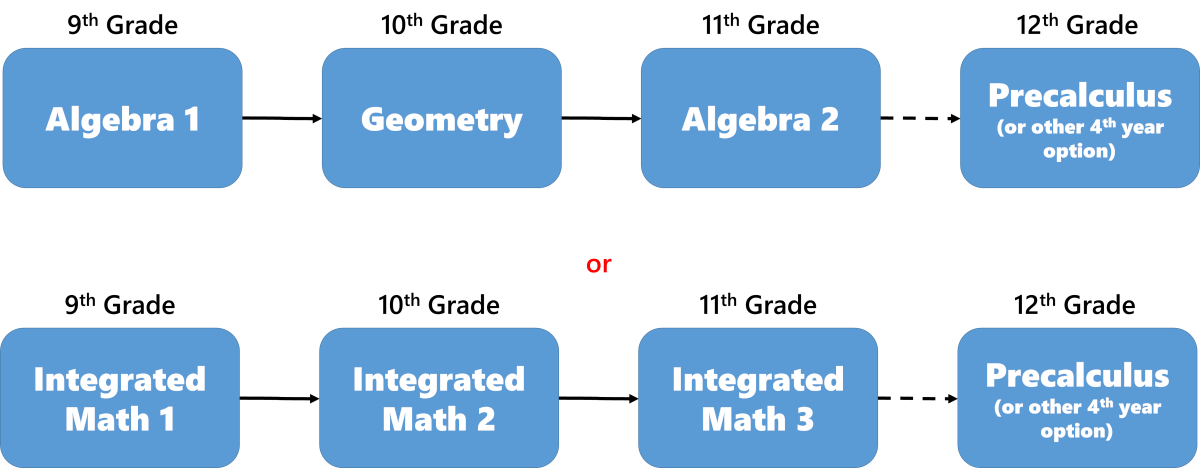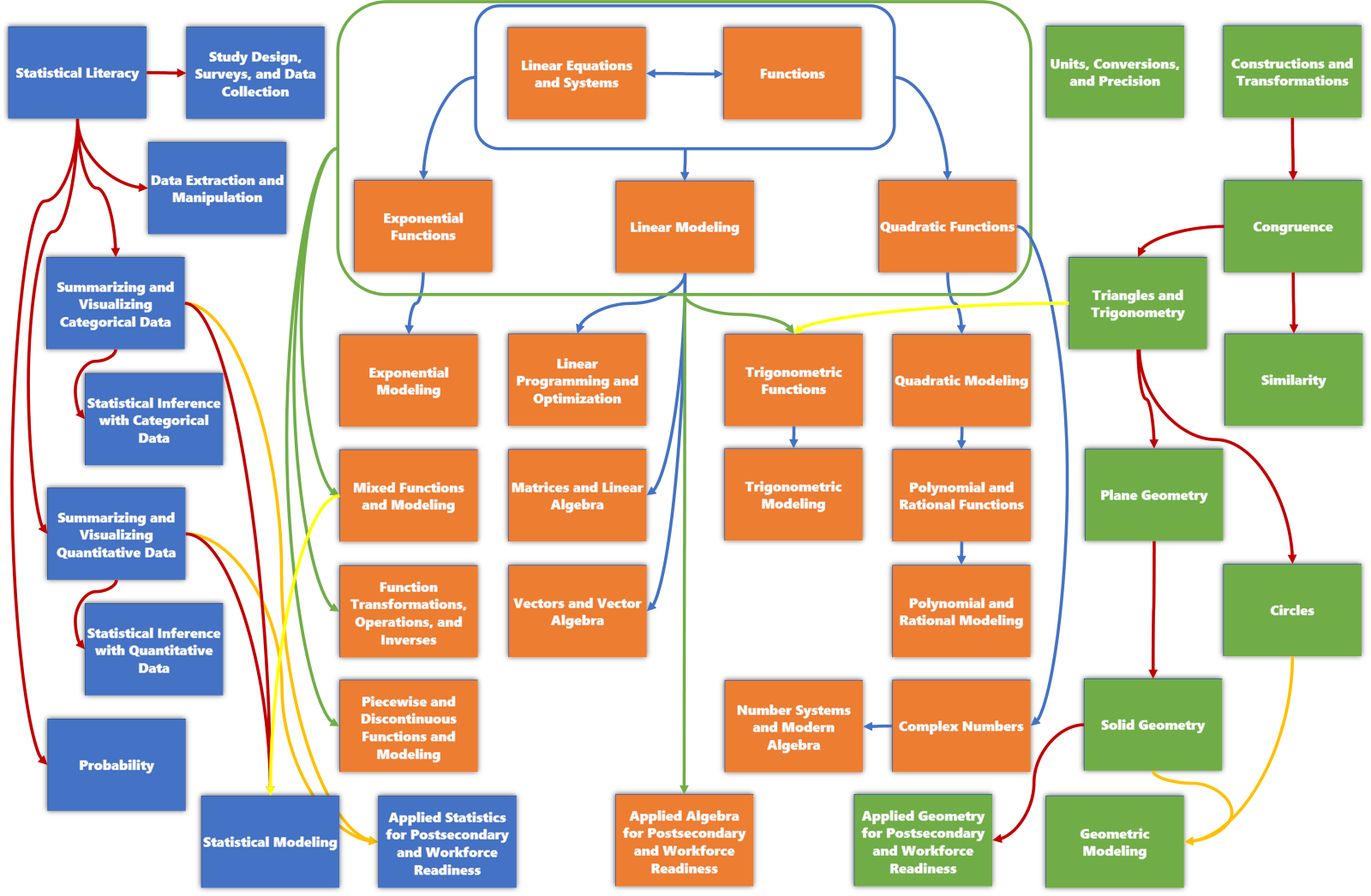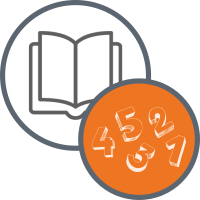CDE will be closed Wednesday, Nov. 27 through Friday, Nov. 29 for the Thanksgiving holiday.
You are here
Mathematics Pathways, Accelerating Learning, and Credit Recovery
Curriculum Support Menu
Mathematics Pathways, Accelerating Learning, and Credit Recovery
In general, mathematics "pathways" refers to sequences of courses or other learning opportunities that foster a students' mathematical development according to their interests with a goal of creating more opportunities for all. Pathways have become an area of national focus, driven in part by publications like NCTM's Catalyzing Change series of books, convenings of the Conference Board of Mathematical Sciences, and support of organizations like the Dana Center at the University of Texas at Austin. In Colorado's higher education system, a Math Pathways Task Force took on the issue of pathways and generated a report of recommendations at the conclusion of their work in 2016. These recommendations included defined pathways for calculus, statistics, and quantitative literacy, along with increased advising capacity and ongoing working groups. At PreK-12 in Colorado, pathways have become a common topic of discussion for mathematics teachers and specialists, with an increasing number of people looking to innovate and resolve long-standing issues affecting access, achievement, relevancy, and equity in mathematics learning, especially in high school.
An Overview of Mathematics Pathways
For preschool through 12th grade, Colorado statutes require academic standards to describe what students should know and be able to do in mathematics. While there are progressions of learning inherent in these standards, described as coherence connections, the state does not dictate the content of individual courses or the construction of mathematics pathways. Generally, schools offer a daily math class or learning time in PreK-8, with the content of each class aligned to the academic standards for that grade.
In high school, opportunities to learn mathematics vary more. Most schools use the "traditional" sequence of Algebra 1, Geometry, and Algebra 2, while others offer an "integrated" sequence, which may be called Mathematics 1, Mathematics 2, and Mathematics 3, or something similar. Opportunities to learn mathematics vary even more for 11th and 12th graders, with some pursuing courses like precalculus or statistics, some taking college math courses through concurrent enrollment opportunities, some pursuing credit through AP courses, typically in calculus or statistics, and others earning math credit for courses like consumer math, computer-aided design and drafting, construction math, computer programming, nursing, or other postsecondary and workforce readiness (PWR) related classes for which a school district has determined some amount of math credit can be earned.

Typical traditional and integrated mathematics pathways.
In Catalyzing Change, NCTM makes the following key recommendation for the organization of high school mathematics:
High schools should offer continuous four-year mathematics pathways with all students studying mathematics each year, including two to three years of mathematics in a common shared pathway focusing on the Essential Concepts, to ensure the highest-quality mathematics education for all students. (p. 83)
NCTM outlines two possible pathways:
- Pathway A is the "Geometry First" pathway. The first semester of 9th grade would focus on Essential Concepts in geometry and measurement, followed by a focus on the Essential Concepts in statistics in the second semester of 9th grade. All 9th graders would start at the same point and build on their study of geometry and statistics in 8th grade. In the following three semesters (10th grade and the first half of 11th grade), students would focus on the Essential Concepts of algebra, building on their study of algebra in middle school. The remaining 1.5 years of high school math would include the study of mathematics in courses to serve students' future needs and interests.
- Pathway B is the "Integrated Approach" pathway. During the first year, students would study geometry and measurement, descriptive statistics, and graphing in the coordinate plane. Like Pathway A, all 9th graders would start at the same point. In the second year, students would continue their study of algebra, including exponential equations and functions. In the third year, students would analyze function families related to quadratic and exponential functions, as well as study statistical inference and probability. This could be a semester-long or year-long experience, depending on pacing. The remaining year or 1.5 years of high school math would include the study of mathematics in courses to serve students' future needs and interests.
Are pathways and tracking the same thing?
Pathways and tracking are not the same thing. In fact, pathways are usually described in direct contrast to tracking. With pathways, students self-select into courses or learning opportunities based on their interests. With tracking, students are placed into various "high" or "low" tracks based on their perceived ability. After decades of research showing that, in many cases, detracking improves student outcomes, the major organizations in mathematics education have taken positions against tracking:
What is Colorado's position on tracking and/or acceleration?
In Colorado, neither state statute nor State Board of Education policy promote or prohibit tracking, so it is left to local districts and schools to determine their own policies. C.R.S. 22-7-1013(2.5) requires that each local education provider review its procedures concerning academic acceleration for students. Those reviewing their mathematics acceleration policies may want to consider NCTM's position statement, "Providing Opportunities for Students with Exceptional Promise," which advocates for strong bodies of evidence, a variety of learning opportunities, and ensuring that mathematical concepts are not skipped or rushed. Accelerating students may or may not be done together with identifying students as gifted, or providing services to gifted students, which has its own set of statutes and recommendations. These are explained on the website for CDE's Office of Gifted Education and may be useful when considering district acceleration policies.
Many states and districts are using this guidance and the work of their own stakeholder committees to redesign their high school mathematics pathways. This includes notable efforts such as San Francisco Unified School District, which is committed to starting all 9th graders with Algebra 1, then offering a variety of pathways to accelerate during high school to open up opportunities to take AP Calculus and AP Statistics as 12th graders. Under this system, SFUSD is seeing increased achievement in high school from all students with more students in AP classes than before their pathway reforms, when students accelerated during middle school. In Alabama, their state's Course of Study describes a pathway that starts high school with geometry and statistics (p. 177) and a wide variety of 4th-year credit options (p. 178). These and other ideas are just examples of the many pathway reforms happening around the country and may be useful to Coloradoans seeking to learn more about what is being tried in other places.
For Credit Recovery and Accelerating Learning, Make More Flexible Paths
"To recover from COVID, all students are going to need the same kinds of flexible opportunities that we usually give alternative school students."
-- A Colorado district math leader
One problem with pathways as they are usually described is that it reinforces the myths that (1) all math credit must be earned in course-sized experiences and (2) pathways are mostly linear and require learning each topic before the next. Interruptions to mathematics learning due to the COVID-19 pandemic have taught us that in order to recover credits and get back on track, schools are going to need to provide opportunities to students that offer more flexibility to follow multiple pathways and earn pieces of credits at the same time. Even before the pandemic, too many students would get "stuck" in a high school math pathway, feeling like they faced some insurmountable hurdle before they could make further progress in mathematics. Now, with so many students having fallen behind, seeing past these "one whole course and credit at a time" myths is going to be especially important.
Just as courses and pathways are under the control of local schools and districts in Colorado, so is the awarding of credit for mathematics learning. Local control comes with local flexibility, and the ability to innovate to overcome problems. Schools and districts looking to accelerate mathematics learning by taking a "modular" approach to math credits, with modules organized into multiple pathways, may consider an organization of topics like this:

A conceptual example of the organization of high school math topics, illustrating the multiple paths that may be possible.
The example above contains 40 modules (20 in algebra and functions, 10 in statistics and probability, and 10 in geometry and measurement), each of which could be a month-long experience in a typical classroom setting, worth 1/8th of a math credit. Students could traverse multiple pathways at the same time, and accumulate the successful completion of modules until they've earned whole credits. Again, this is only provided as a conceptual example of the kind of thinking that may be helpful when designing systems for accelerating high school learning and helping students recover or catch up on math credit. While this still leaves a lot of details to work out locally, the recommendation is to focus on two big ideas:
- Mathematics learning experiences can be much shorter than year-long or semester-long courses, and students' progress can add up to full credits.
- Mathematics learning can follow multiple pathways at once, which can help students earn credit at an accelerated rate.
If you are interested in innovating your mathematics pathways, or want to learn more, contact CDE's mathematics specialist using the contact info below. Pathways are a common topic of conversation among members of the Colorado Math Leaders and CCTM, as well as their national-level organizations NCSM and NCTM. If districts share their interests in pathways, that could open opportunities to collaborate and find stronger, shared solutions, or simply learn from each other as we try to help students engage in a more meaningful high school mathematics experience.
Last updated May 4, 2021
For further assistance, please contact:




Connect With Us




